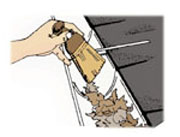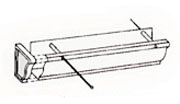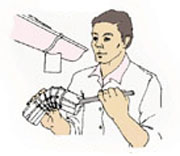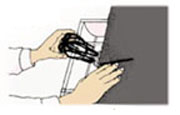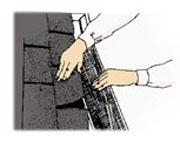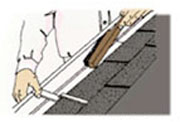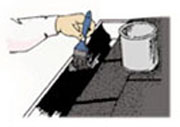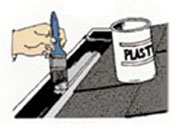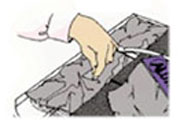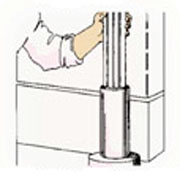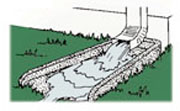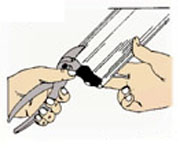|
|
Following are tips and suggestions on how to repair and maintain downspouts and gutters. These ideas can save you a lot of trouble and expense and help you lengthen the life of your gutters and downspouts. Inside this document you will find information about:
- Why You Should Maintain Downspouts and Gutters
- Adjusting the Pitch of Gutters
- Stopping Clogs in Gutters and Downspouts
- Patching Leaks in Gutters
- Maintaining Downspouts
|
|
|
|
|
| FIG. 1 - Debris in
gutters causes clogging and rust. |
| |
|

WHY YOU SHOULD MAINTAIN DOWNSPOUTS AND GUTTERS
- Taking the time to maintain and repair downspouts and gutters can double or even triple the life of your roof drainage system. This can save you a lot of money on repair costs.
- Inspect your downspouts and gutters about twice a year. Carefully examine them in the spring just before the spring rains. Inspect them again in the fall when leaves, limbs and other debris might cause problems.
- Improper drainage due to poor roof pitch is one of the biggest causes of roof drainage problems. Improper drainage causes water to accumulate in certain spots in the gutters, ultimately building up debris and accelerating rust.
- Clogged gutters and downspouts can also be a big problem. Thoroughly clean all debris from the gutters and downspouts at least twice a year (Fig. 1). If there are a number of trees near your home, clean the gutters with a whisk broom even more often than twice a year.
- Rust can be a big problem. Keep the gutters properly cleaned and the pitch set correctly to slow down the rusting process.
|
|
|
|
|
| FIG. 2 - Spans of
gutters that reach 35' or more should slop in both directions. |
|
|
|
| FIG. 3 - Improper
pitch can sometimes be corrected by bending the hanger that supports
the gutter. |
|
|
|
| FIG. 4 - Remove low
spots by adding spikes and sleeves. |
|
|

ADJUSTING THE PITCH OF GUTTERS
- The gutters on your home should be installed so there is a drop of approximately 1/16" for each 1' of length of guttering.
- You can use a chalk line and a level to take a reading and mark the slope of your gutters. Another way is to pour a bucket of water into the gutter and observe the flow. If it runs off without leaving pools of water in the gutter, the gutter is set properly. If there are low spots, the water will sit in the gutter and locate the trouble spots.
- Ordinarily, the pitch of a gutter can be set in only one direction. However, gutter runs of more than 35' should slant in each direction from the center (Fig. 2). Again, the drop should be set at a rate of 1/16" of fall for each 1' of gutter.
- High or low spots detected in the gutter run can often be corrected by bending the hanger than supports the gutter (Fig. 3). A slight bend up or down can often remove the low or high spot.
- Some gutters are installed with spikes and sleeves, sometimes called spikes and ferrules (Fig. 4). You may need to add an additional spike or sleeve to raise or lower the fall of the gutter at any specific point.
- When extra spikes or sleeves are added, use a power drill to make a hole through the gutter before inserting the spike and sleeve.
- Gutters are usually held in place with either spikes and sleeves or hangers.
- There are two basic types of gutter hangers. One is the strap hanger (Fig. 5). This type of hanger supports the gutter with a wraparound strap underneath the gutter. A long strap is then affixed to the top and nailed to the sheathing under the edge of the roof. The roofing material covers the strap, making it totally inconspicuous.
- The bracket hanger is nailed or screwed to the fascia underneath the eave of the roof (Fig. 5). Either of these types of hangers can be added as needed to remove high and low spots in a run of gutter. Add braces that matchthose already in use.
|
|
|
|
|
| FIG. 6 - Drains often
clog at the elbow. |
|
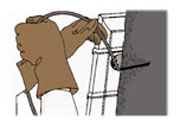 |
| FIG. 7 - You can use
a plumber's or electrician's snake to clean downspouts. |
|
|
|
| FIG. 8 - Install leaf
strainers at downspout outlets. |
|
|
|
| FIG. 9 - It's a good
idea to install leaf guards over all gutters. |
| |
|

STOPPING CLOGS IN GUTTERS AND DOWNSPOUTS
- Clogging usually occurs in a drainage system at the elbow where the downspout connects to the gutter (Fig. 6). Since this elbow is relatively easy to remove, it is a good idea to remove it and inspect for clogging.
- If the clogging is not in the elbow, check farther down the downspout.
- You can usually check the downspout from the bottom. However, if the downspout is inserted in an underground tiling system, you may need to use a plumber's or electrician's snake to clean the downspout (Fig. 7). This type of metal snake can be used to penetrate the downspout for a great distance, removing any obstacles causing clogging and backup problems.
- If your roof drainage system is exposed to falling leaves and debris, you should install leaf strainers in all downspout outlets (Fig. 8). These strainers insert into the downspout outlet. They permit the free passage of water but stop any leaves or other objects that can cause problems in downspout drainage.
- Leaf strainers are easy to install and are relatively inexpensive.
- You can solve most drainage problems by installing leaf guards over your entire gutter system (Fig. 9). There are various types of leaf guards available.
- Leaf guards of metal, plastic, etc., are usually mounted in the same way. Lift the lower run of shingles and insert the leaf guard underneath. Some leaf guards clamp over the edge of the gutter.
- The leaf guards hold the leaves and other falling debris on top of the guard while allowing water to flow freely through the drainage system. The leaves then dry on top of the guard and are quickly blown away.
|
|
|
|
|
| FIG. 10 - Scrape off
allrust on the gutter with a steel brush. |
|
|
|
| FIG. 11 - Cover the
area with a rust treatment or rust-inhibiting paint. |
|
|
|
| FIG. 12 - Coat the
area with a heavy layer of plastic cement. |
|
|
|
| FIG. 13 - Cover the
area with heavy aluminum foil or plastic before the cement dries. |
| |
|

PATCHING LEAKS IN GUTTERS
- Any type of gutter will ultimately need some mending or repairing. However, aluminum and plastic gutters and downspouts last much longer than those made of galvanized steel.
- When leaks occur, you may want to totally replace entire sections of the gutter rather than trying to mend them. However, small leaks and rust spots can easily be patched or mended.
- The first step in repairing a rusted and leaky gutter is to scrape off all the rust (Fig. 10). Use a steel brush or a 1/4" drill and a power rotary brush.
- Take time to remove as much of the rust as possible. Old rust left underneath the mending job simply starts to work again.
- Next, cover the area to be repaired with either a rust treatment or rust-inhibiting paint. Allow it to dry thoroughly (Fig. 11).
- For small holes, apply a 1/8" thick layer of plastic cement specially made for gutter repairs or use ordinary roof cement (Fig. 12).
- For larger holes, follow this same procedure. While the cement is still wet, cover the area with strips of heavy aluminum foil or plastic (Fig. 13). Cut the patch material to fit exactly inside the repaired area.
- Press the patch down tightly into the gutter with a dry cloth. Wear gloves during this part of the repair job.
- When joining two pieces of patch material, overlap it in the direction of the water flow and cement the edges together securely. Be sure the overlap is in the direction of the water flow–otherwise, water may enter at the seam.
|
|
|
|
|
| FIG. 14 - Be sure
all underground drains are open. |
|
|
|
| FIG. 15 - Be sure
splash blocks are under all downspouts and that they carry water
away from the house. |
|
|
|
| FIG. 16 -You may need
to add extra downspouts. |
|
|
|
| FIG. 17 - Downspouts
can be crimped and inserted over another piece of downspout. |
| |
|

MAINTAINING DOWNSPOUTS
- Even the best gutter system cannot function properly unless all downspouts are in working order. Take the time to examine your downspout system at the same time you are mending and repairing your gutters.
- If the downspouts drain into an underground tile system, make a careful check at the point where the downspout enters the underground tiling (Fig. 14). Make sure it is cemented firmly into place and there is no backup or overflow.
- You can use a plumber's or electrician's snake to clean any possible obstructions in the downspout system.
- Most downspouts empty onto a splash block (Fig. 15). Be sure these splash blocks are large enough and high enough to carry the water away from the foundation of the house.
- Check the splash blocks occasionally to make sure they are not broken or deteriorating. Downspouts that pour water around the foundation of the house can cause basement or crawl space water problems. Secure splash blocks remove much of this danger.
- You may need to add extra downspouts to carry water completely away from the house (Fig. 16).
- You can attach an extra length of downspout at the elbow to continue it as far away from the house as necessary.
- Special roll-up downspout sheets are available that extend themselves when filled with water and roll up when the water is emptied. These perform the same function as an extended downspout, but they avoid the unsightliness of the downspout extended into the yard.
- Add downspout simply by crimping the end of the material with a pair of pliers (Fig. 17). The new piece of downspout will slip easily into the original piece.
|
|
| Check your state
and local codes before starting any project. Follow all safety precautions.
Information in this document has been furnished by the National Retail Hardware
Association (NRHA) and associated contributors. Every effort has been made
to ensure accuracy and safety. Neither NRHA, any contributor nor the retailer
can be held responsible for damages or injuries resulting from the use of
the information in this document.
|



